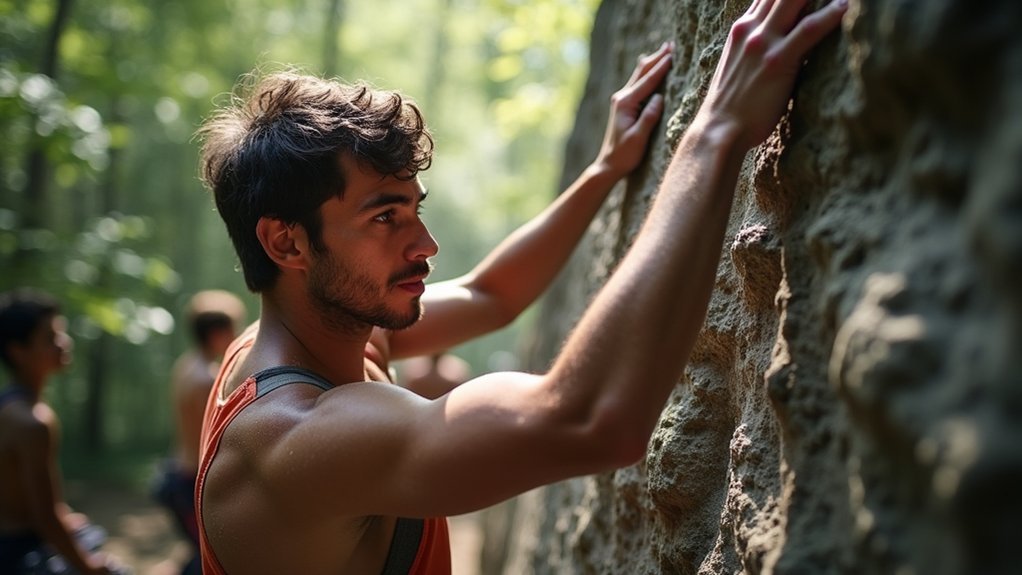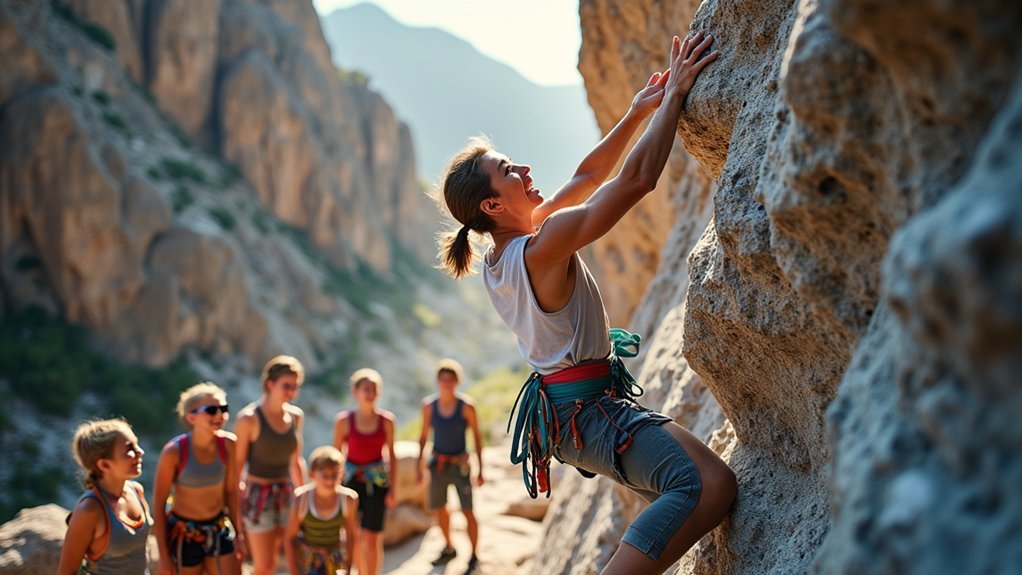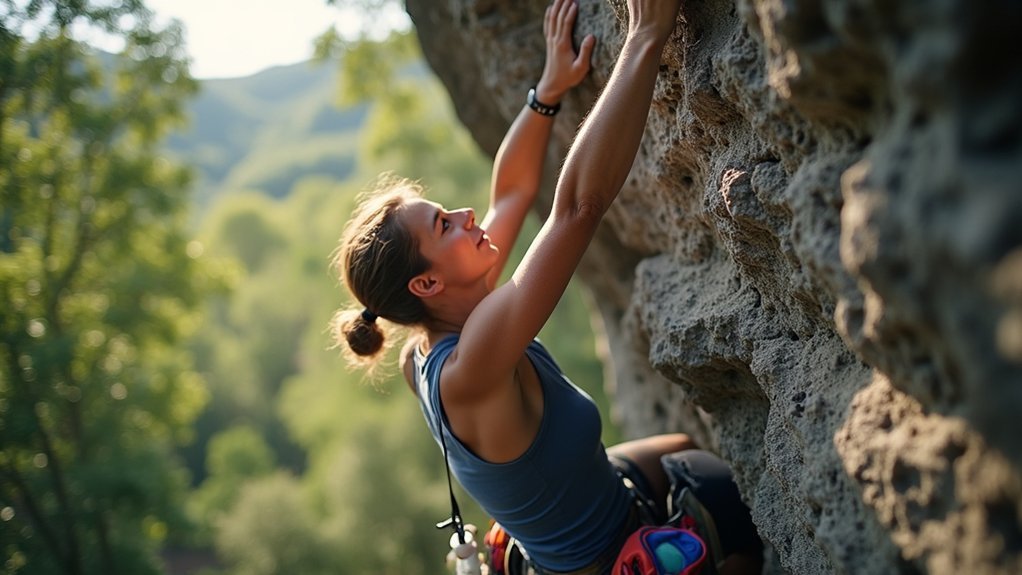Focus on developing unilateral strength through one-arm pull-ups and uneven-grip variations. Master balance by shifting your center of gravity toward your stronger side while engaging your core. Train progressively based on your ability level, starting with two-arm hangs and advancing to one-arm movements. Consider adaptive equipment like specialized harnesses or climbing-specific prosthetics if needed. Don’t skip recovery days—schedule rest between sessions and prioritize proper technique to prevent injuries. The following strategies will transform your climbing approach completely.
Building Essential Strength for One-Arm Climbing Movements

While many climbers dream of mastering one-arm techniques, you’ll need to develop specific unilateral strength before attempting these advanced moves. Incorporate one-arm pull-ups and uneven-grip variations to target each side of your body independently, creating the foundation for successful one-arm climbing.
Don’t overlook foundational training like single-leg deadlifts and pistol squats, which enhance body balance and coordination essential for efficient movement on the wall.
Balance from below powers movement above. Master single-leg exercises to unlock your climbing potential.
For grip strength, progress from two-arm hangs to one-arm holds, gradually increasing duration to build endurance.
Focus on proper form during all exercises, especially shoulder-intensive movements, to prevent injuries that could derail your progress.
Train consistently 2-3 days weekly, varying your exercises, reps, and sets to continue making strength gains without hitting plateaus.
Mastering Balance and Body Positioning Techniques
Once you’ve built the necessary strength foundations, your success with one-arm climbing hinges on mastering precise balance and body positioning. Shift your center of gravity toward your stronger side while engaging your core muscles to create a stable platform for movement.
- Strategically position your feet to distribute weight evenly across your body, using deliberate foot placements to push against the wall and reduce strain on your supporting arm.
- Experiment with different body angles by tilting your torso toward the wall, which increases stability when reaching with one arm.
- Control your dynamic movements carefully, maintaining balance during shifts between holds by keeping your core engaged and your weight distribution mindful.
Remember that effective one-arm climbing isn’t just about strength—it’s about creating harmony between balance, positioning, and movement.
Progressive Training Methods for Different Ability Levels

With balance and body positioning techniques now in your arsenal, the right training progression will determine your success in one-arm climbing. Start with two-arm hangs to build your foundation before attempting one-arm variations.
| Ability Level | Training Focus | Training Frequency | Key Exercise | Progression Indicator |
|---|---|---|---|---|
| Beginner | Foundational grip | 2 days/week | Two-arm hangs | 30-second hold |
| Intermediate | Uneven loading | 2-3 days/week | Uneven-grip pull-ups | Full range of motion |
| Advanced | Assisted one-arm | 3 days/week | Band-assisted hangs | Decreasing assistance |
| Elite | Lock-off strength | 3 days/week | One-arm hangs | 5-second holds |
| Professional | Controlled movement | 2 days/week | One-arm pull-ups | Fluid execution |
You’ll need consistent training to progress through these levels. Always maintain proper form and avoid rushing progressions. Your body needs time to adapt to each challenge before moving forward.
Adaptive Equipment Options for One-Arm Climbers
Because climbing traditionally demands two-hand techniques, adaptive equipment plays an essential role for one-arm climbers seeking to navigate vertical terrain safely. The right gear can transform your climbing experience by providing vital support and balance.
- Specialized harnesses distribute weight evenly across your body, enhancing stability while allowing freedom of movement on challenging routes.
- Prosthetic devices designed specifically for climbing offer improved grip capabilities, letting you tackle holds that would otherwise be impossible with one arm.
- Belay management tools like the Grigri or Hewbolt Single enable you to control rope slack efficiently, while adjustable tethers provide secure anchoring without limiting mobility.
Organizations like Paradox Sports offer valuable workshops where you’ll learn about equipment options tailored to your specific needs as a one-arm climber.
Recovery Strategies to Prevent Shoulder and Arm Injuries

As one-arm climbers face unique physical demands, implementing effective recovery strategies becomes essential for long-term shoulder and arm health.
Schedule active rest days between intense climbing sessions to allow tissues to repair while maintaining blood flow to affected areas.
Incorporate foam rolling and targeted stretching after each session to release tension in your shoulders and arms. This helps maintain muscle balance, especially important when performing unilateral strength training exercises.
Monitor your training intensity carefully, gradually increasing difficulty to prevent overtraining.
Begin each session with dynamic warm-ups that prepare your shoulder complex for load-bearing movements.
Remember that injury prevention isn’t just about recovery—it’s about preparation too. Proper technique during climbing and strength exercises provides the foundation upon which effective recovery strategies can build.
Frequently Asked Questions
How Strong Do I Need to Be to Do a One Arm Pull Up?
You’ll need to perform 10-15 regular pull-ups consistently, lift about 70-80% of your bodyweight with one arm, and master exercises like one-arm negatives and lock-offs held for 8-10 seconds.
How Can I Improve My One Arm Lock Off?
To improve your one-arm lock-off, practice lock-offs at various angles for 8-10 seconds, try uneven-grip pull-ups, perform one-arm negatives with 5-second descents, and do assisted one-arm hangs 2-3 days weekly.
Do One-Arm Hangs Help Climbing?
Yes, one-arm hangs directly strengthen your grip, improve finger strength, and enhance shoulder stability—all critical for climbing. You’ll notice better performance on routes with small holds and challenging moves as you progress.
How Do You Get up With One Arm?
To get up with one arm, engage your core, push with your legs, and position your body close to the wall. Twist your torso strategically and use opposing footholds for balance as you move upward.
In Summary
You’re now equipped to start your one-arm climbing journey regardless of your experience level. Remember, it’s not about immediate mastery but consistent progress. Focus on building targeted strength, refining your technique, and training progressively. Don’t hesitate to use adaptive equipment when needed, and always prioritize proper recovery. With patience and dedication, you’ll soon discover new possibilities on the wall that you never thought possible.





Leave a Reply